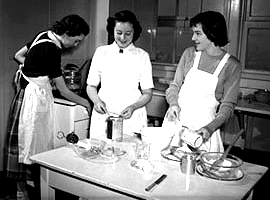Home Economics, 1900 - 1950

Home Economics Class, Kitsilano Junior-Senior High School, Vancouver, 1949
BC Archives photo HP-00486
Courses relating to the use of foods and textiles were introduced to British Columbia schools in the early 1900s, about the same time as manual arts classes were established. Like manual arts, home economics was part of a broad educational movement intended to promote efficiency and progressivism.
The purpose of home economics - or domestic science as it was known prior to 1911 - was not simply to teach sewing and cooking, but rather to apply "scientific principles to the management of the home."
Margaret Jenkins, a Victoria school trustee, was instrumental in establishing the province's first "domestic science centre" in 1903. Located in Girl's Central School , Victoria, it boasted a coal-fired stove and a modern gas cooking range. It was equipped through funds raised by the Victoria chapters of the Local Council of Women and the Woman's Christian Temperance Union.
In 1905, the province's second domestic science centre was established at King Edward High School in Vancouver. Like the Victoria centre, it was equipped with money raised by local women's organizations. The Vancouver centre was managed by Elizabeth Berry, a graduate of the Macdonald Institute in Guelph, Ontario.
Domestic science teachers were recognized officially in the Public School Act of 1905 and shortly afterwards "home economics" was approved as an optional subject in the provincial curriculum. The provincial government provided school boards with annual grants (up to a maximum of $500 per year) towards the cost of domestic science equipment. But the grants fell far short of the actual costs of properly equipping instructional centres, and as result even comparatively wealthy city school districts relied on the support of local women's organizations and community groups - notably Parent-Teacher Associations - for equipment.
As was the case with so many of the "new education" programs, home economics was slower to develop in rural areas. In most cases, rural and assisted school districts could not afford to equip domestic science centres or afford the salaries of well-qualified domestic science teachers. Nevertheless, rudimentary courses in hygiene, nutrition, food preservation, and needlework were established with the assistance of Alice Ravenhill and the rural Women's Institutes of British Columbia. The Household Science Branch of the provincial Department of Agriculture, organized in 1919, was also active in promoting home economics in rural and in rural municipal school districts.
Initially, the Department of Education relied on John Kyle, Organizer of Technical Education, to regulate the home economics program. But as new and more specialized courses were developed, the need for a qualified, full-time coordinator was increasingly felt. Putman and Weir recognized the need in 1925.
In their Survey of the School System, the commissioners wrote: "Home economics cannot, in our opinion, be organized and directed properly except by a thoroughly competent woman acting as provincial director. The right type of woman is not easily found. She needs to have tact in dealing with the public, executive ability, training for leadership, and, above all, good judgement and a genius for practising economy" (p. 338).
Jessie L. McLenaghen was the ideal candidate. A graduate of the Home Economics departments at the University of Toronto and Columbia University in New York, she had taught the subject at the Saskatchewan Normal School. In April 1926 she was appointed director of the newly-established Home Economics Branch of the Department of Education. She was the first woman to hold a director's position within the department.
Under McLenaghen's direction, more home economics centres were opened in the province's largest school districts. Home economics "instructional kits" were also made available for small rural and assisted school districts. In 1936, home economics was made a compulsory subject for Grade 7 and Grade 8 in the British Columbia's city and municipal school districts
The position of Inspector of Home Economics was created in 1941. The first inspector was Bertha Rogers, formerly a teacher at Oak Bay High School in Victoria. She succeeded McLengahen as director of the Home Economics Branch in 1946. By that time, home economics was being taught to nearly 18,000 students in over one hundred provincial public schools.
In the early 1900s, the home economics curriculum was rather loosely defined; courses were limited to a few schools in Victoria and Vancouver and the syllabus was determined by local advisors. But as home economics classes were established in other school districts, a province-wide curriculum emerged. A comprehensive curriculum was first published in 1920. The program may have been inspired by progressivism, but the curriculum itself was very pragmatic and utilitarian. It involved laundry-work, practical cookery, dietetics, and household management. The 1920 curriculum also included some very basic Rules relating to Domestic Science Centres.
The home economics curriculum was completely revamped in 1936. A much more ambitious, expansive philosophy -- a philosophy associated with character education -- imbued the syllabus issued by the Department of Education in 1937. Girls in Grade 7 were encouraged to be "intelligent mother's helpers" and to be aware of their personal appearance in the 1937 junior high home economics syllabus. Likewise, the "Development of a Pleasing Personality" was an important unit in the 1937 high school home ec curriculum.
The curriculum was not revised substantially again until the 1960s.
Written by Patrick A. Dunae
References:
British Columbia, Annual Reports of the Public Schools (1906
- 1947); Home Economics' Heritage from the Past (Vancouver: BCTF,
1971); Patrick A. Dunae, The School Record (Victoria: BCARS, 1992),
pp. 61-64; Mary Leah DeZwart, "Proving Its Worth: Jessie McLenaghen and
Home Economics in British Columbia," Canadian Home Economics Journal/revue
canadienne d'economie familiate, Vol. 41, No. 3 (Summer 1991), 134-139;
and DeZwart, "Voices of the Pioneers: Their Struggle for Legitimacy and
Recognition," Canadian Home Economics Journal/revue canadienne d'economie
familiate, Vol. 45, No. 4 (Fall 1995), 139-142.

